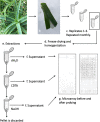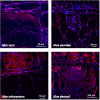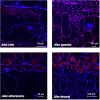Detection of Seasonal Variation in Aloe Polysaccharides Using Carbohydrate Detecting Microarrays
- PMID: 31139197
- PMCID: PMC6527838
- DOI: 10.3389/fpls.2019.00512
Detection of Seasonal Variation in Aloe Polysaccharides Using Carbohydrate Detecting Microarrays
Abstract
Aloe vera gel is a globally popular natural product used for the treatment of skin conditions. Its useful properties are attributed to the presence of bioactive polysaccharides. Nearly 25% of the 600 species in the genus Aloe are used locally in traditional medicine, indicating that the bioactive components in Aloe vera may be common across the genus Aloe. The complexity of the polysaccharides has hindered development of relevant assays for authentication of Aloe products. Carbohydrate detecting microarrays have recently been suggested as a method for profiling Aloe polysaccharide composition. The aim of this study was to use carbohydrate detecting microarrays to investigate the seasonal variation in the polysaccharide composition of two medicinal and two non-medicinal Aloe species over the course of a year. Microscopy was used to explore where in the cells the bioactive polysaccharides are present and predict their functional role in the cell wall structure. The carbohydrate detecting microarrays analyses showed distinctive differences in the polysaccharide composition between the different species and carbohydrate detecting microarrays therefore has potential as a complementary screening method directly targeting the presence and composition of relevant polysaccharides. The results also show changes in the polysaccharide composition over the year within the investigated species, which may be of importance for commercial growing in optimizing harvest times to obtain higher yield of relevant polysaccharides.
Keywords: Aloe; authentication; carbohydrate detecting microarrays; plant cell walls; polysaccharides; seasonal variation; succulent tissue.
Figures






References
-
- Albersheim P. (2011). Plant Cell Walls?: from Chemistry to Biology. Taylor, MI: Garland Science.
-
- Beppu H., Shimpo K., Chihara T., Kaneko T., Tamai I., Yamaji S., et al. (2006). Antidiabetic effects of dietary administration of Aloe arborescens Miller components on multiple low-dose streptozotocin-induced diabetes in mice: investigation on hypoglycemic action and systemic absorption dynamics of aloe components. J. Ethnopharmacol. 103 468–477. 10.1016/j.jep.2005.10.034 - DOI - PubMed
-
- Bozzi A., Perrin C., Austin S., Arce Vera F. (2007). Quality and authenticity of commercial Aloe Vera gel powders. Food Chem. 103 22–30. 10.1016/j.foodchem.2006.05.061 - DOI
LinkOut - more resources
Full Text Sources

